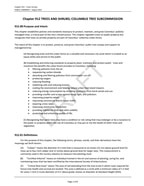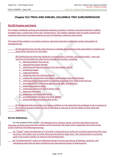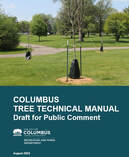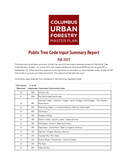Public Tree CodeTo reach the goals from the Urban Forestry Master Plan (see inset), stronger tree protections are needed on both public and private land (see Actions 14 and 15) according to national standards and best practices in urban forestry.
The City of Columbus worked on updating the public tree code throughout 2022 and 2023. The new code was adopted by City Council on December 11, 2023. The final version of the code voted on can be found here (PDF format). |
COLUMBUS' GOALS FOR THE URBAN FOREST
In 2021, with the support of the Mayor’s office and leadership from Columbus Recreation and Parks Department, Columbus City Council approved Columbus’ first strategic plan for its trees: the Urban Forestry Master Plan (UFMP). The UFMP is the first Citywide, strategic plan to invest long-term in Columbus’ trees. The UFMP will guide the entire Columbus community to prioritize, preserve and grow our tree canopy through three goals: 1. Reach Citywide Tree Canopy Cover of 40% by 2050. 2. Stop the Net Canopy Losses by 2030. 3. Invest in Equitable Canopy Across All Neighborhoods by 2030. |
WHAT changeD
|
There were a number of changes made to better protect public trees in Columbus:
1. A Companion Manual to Aid in Better Outcomes. For the first time, code changes allow the creation of a Tree Technical Manual that carries the force of City code. This is important because it means the department can both provide more detail on meeting code with guidance and best practices, and it can be updated more frequently than City code, allowing it to be a living document that can change with advances in the forestry industry. The creation of a best practices manual is a UFMP recommendation (Action 9). |
WHAT IS TREE MITIGATION?
Because of the value of trees in Columbus, and in efforts to achieve city urban forestry goals, the City of Columbus takes removal of a public tree seriously. For this reason, if a removal is approved, steps will be required to make up for the loss of that tree – a practice that is termed tree mitigation. Mitigation can take the form of replanting, payment into a tree fund (also known as “fee-in-lieu”), or a combination of both. |
2. Mitigation Now Applies to All Projects. In the prior system, there were loopholes that resulted in healthy trees not being replaced when work occurred on public land. For example, the 2015 Executive Order exempted routine maintenance, as well as projects funded solely with private sector contributions. The fact that some projects didn’t require any tree preservation or replanting directly contributed to tree canopy loss over time in Columbus. The new code removes these exemptions, ensuring all construction and utility projects on City property must comply with the tree mitigation requirements.
|
3. Stronger Valuation of Trees and Inch-for-Inch Replacement. In the prior system, the tree valuation and replacement practices did not accurately reflect the value of trees in Columbus. The new tree code places a higher value on trees, both in its appraisal of value, as well as in the replacement rates required for trees removed.
|
COMPARING CURRENT AND PROPOSED MITIGATION
In the prior system, trees replacement was based on a ratio system: 1:1 up to 5:1 tree replacement, depending on the size of the removed tree. For example, a 20” diameter tree would only need to be replaced by three new trees. In the new “inch for inch” system, that same 20” diameter tree would need to be replaced with 10 replacement trees of 2” caliper each. 10 trees x 2” = 20” in replacement tree inches. (Caliper is used to measure nursery trees 12” above the ground, as opposed to diameter for mature trees.) |
4. Better Enforcement. Forestry arborists are needed to provide technical expertise to facilitate mitigation throughout the construction process. In the prior system, enforcement had been a challenge because of lack of resources and staff. The new system requires Forestry arborists to be dispatched to inspect construction projects up to five times, before, during and after construction is complete to ensure public trees are protected and newly-planted trees survive. The additional resources needed for this enforcement work is now included in inspection fees.
5. In Line with Best Practices. The prior public tree code was out of date with urban forestry best practices nationally in a number of ways:
6. Clarity in Goals and Structure. In the prior system, project owners had to reference both the code and the Executive Order to ensure compliance. The new system not only combines these into one code, but also reorganizes the ordinance and revises definitions to ease in purpose and readability. Additionally, there is a new “Purpose and Intent” section to introduce the public tree code, which explains why trees are so important to Columbus.
7. Appeals Process. The new code now allows for anyone who receives a notice of violation for a private property nuisance tree or a denial of a variance request to appeal that decision. Recreation and Parks will select a hearing officer who is objective and knowledgeable about urban forestry to hear these appeals and make a final decision.
- Plan Required to Preserve and Replace Trees During Construction. The prior system did not require a Public Tree Plan in construction plan sheets. A public tree plan shows a map of trees to be removed and preserved, tree protection boundaries for each tree to be preserved, as well as critical data for protection measures. These national tree protection best practice is now required and detailed in Columbus Tree Technical Manual.
- Utilization of Experts. The prior system did not require someone with expertise to be consulted on tree protection, preservation and replacement. Work could be undertaken by any contractor, no matter their knowledge level, which can result in poor practices and stressed/dying trees during and after construction. The new code specifically requires tree protection and preservation plans to be developed by a natural resource professional, and reviewed and approved by the Columbus Recreation and Parks Department.
- Tree Species Lists. Prior code listed prohibited tree species, while the recommended tree list was maintained by Forestry and the Columbus Tree Subcommission. The new manual references a comprehensive list of approved tree species for planting along public streets, in parks and public places, as well as an updated list of prohibited species. Keeping these lists outside of City code allows for more frequent updates as the climate warms and species availability change.
- Industry Standards Referenced. In the prior code, there is no reference to what is acceptable tree care versus unacceptable. The new manual cites industry standards for tree care (ANSI A300 standards), and will always be up-to-date on best practices.
6. Clarity in Goals and Structure. In the prior system, project owners had to reference both the code and the Executive Order to ensure compliance. The new system not only combines these into one code, but also reorganizes the ordinance and revises definitions to ease in purpose and readability. Additionally, there is a new “Purpose and Intent” section to introduce the public tree code, which explains why trees are so important to Columbus.
7. Appeals Process. The new code now allows for anyone who receives a notice of violation for a private property nuisance tree or a denial of a variance request to appeal that decision. Recreation and Parks will select a hearing officer who is objective and knowledgeable about urban forestry to hear these appeals and make a final decision.
THE PROCESS
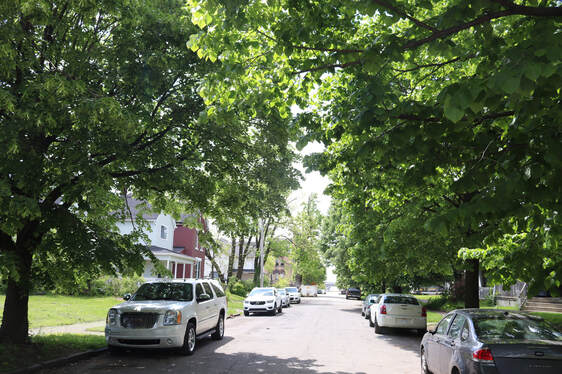
To start, the City held a round of public input in 2022 (summary of 2022 input received can be found here in PDF format) and created a starting code and manual draft based on national best practices.
Then, as this code must be met by City departments and their contractors, over 30 City interdepartmental meetings and listening sessions from fall 2022 to summer 2023 took place to work through implementation logistics and adjust first drafts of code and manual. Recreation and Parks coordinated with the departments of Public Utilities, Public Service, Building and Zoning Services, Development, Finance and Management, Health, Neighborhoods and the City Attorney’s Office. This significant coordination work ensures the updated public tree code can be enforced effectively to protect public trees in Columbus.
Finally, once a final draft was completed, the City Council heard a presentation on the changes in September 2023 (recorded video available), and the code and manual drafts were released for another round of public input (summary of 2023 public input received can be found here in PDF format).
Final changes were made over the course of October and November 2023, and the code was finally adopted on December 11, 2023.
Then, as this code must be met by City departments and their contractors, over 30 City interdepartmental meetings and listening sessions from fall 2022 to summer 2023 took place to work through implementation logistics and adjust first drafts of code and manual. Recreation and Parks coordinated with the departments of Public Utilities, Public Service, Building and Zoning Services, Development, Finance and Management, Health, Neighborhoods and the City Attorney’s Office. This significant coordination work ensures the updated public tree code can be enforced effectively to protect public trees in Columbus.
Finally, once a final draft was completed, the City Council heard a presentation on the changes in September 2023 (recorded video available), and the code and manual drafts were released for another round of public input (summary of 2023 public input received can be found here in PDF format).
Final changes were made over the course of October and November 2023, and the code was finally adopted on December 11, 2023.
the basics
What are public trees, and why are they important? Public trees are all trees growing on City-owned properties. In Columbus, 30% of our overall tree canopy grows on public land. Protecting these trees is important to Columbus’ canopy goals, particularly stopping net loss by 2030. Under the systems in place during the development of the UFMP, it was shown that Columbus was losing more tree diameter inches than are being replaced due to construction.
Who manages public trees? City code gives authority over all trees planted or to be planted on City-owned property to Columbus Recreation and Parks Department. Within Recreation and Parks, the Forestry section is led by the City Forester and conducts all tree plantings, care and removal of trees on City streets and in parks.
Who manages public trees? City code gives authority over all trees planted or to be planted on City-owned property to Columbus Recreation and Parks Department. Within Recreation and Parks, the Forestry section is led by the City Forester and conducts all tree plantings, care and removal of trees on City streets and in parks.
What is tree code? In the U.S., tree code can be grouped into two categories.
- Public trees grow on publicly-owned land such as along streets, in public parks and on all City properties. Columbus Recreation and Parks Department’s Forestry section is solely and legally responsible for all public trees in Columbus. Public trees are governed according to City Code Chapter 912.
- Private trees grow on land that is privately owned, such as residential, commercial and industrial properties, and they are not regulated in the same way in every city. There are two categories of private tree regulations - regulation during development and regulations at all times regardless of whether there is construction or development happening. Private trees are not currently regulated citywide in Columbus, which is unusual for a city of Columbus' size.
|
What was in place for public trees? Prior to this new code, public trees were governed by a combination of two pieces of legislation: City Code Chapter 912 and a 2015 Executive Order (see inset).
Why were improvements needed? The UFMP reviewed existing public tree protections and recommended they be modernized to reflect industry standards and best practices, as well as codify the Executive Order. |
PRIOR PROTECTIONS FOR PUBLIC TREES
City Code Chapter 912: Trees and Shrubs Code adopted over 30 years ago (1991) that gave Columbus Recreation and Parks Department the authority over trees planted or to be planted on City-owned properties. It included some protections for public trees, established a tree fund and the Tree Subcommission. Executive Order 2015-031: (Tree Protection and Mitigation Policy) In 2015, Mayor Coleman signed an executive order that ensures that City construction activities (capital improvement projects) minimized impacts to trees and required tree mitigation via planting or payment-in-lieu. |
public input
Watch the proposed public tree code presentation at Columbus City Council held on Sept. 14, 2023.
Fall 2023 Public Comment Period. We asked for public input on this revised public tree code work, with all public comments due by September 22, 2023. A summary of the changes made in an easy-to-comprehend format is provided in the following section. Additionally, the public can also read the actual documents themselves (which can be somewhat technical) are available, along with a summary public comments received, all linked below.
